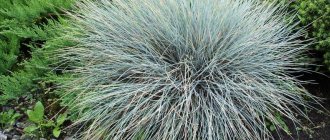Liatris is a perennial whose range extends to most of North America, Canada and Mexico.
For our latitudes, the flower is exotic and has not yet become widespread, but its unpretentiousness, resistance to diseases and pests, as well as spectacular flowering have already created a certain popularity for it.
Types and varieties with photos
Despite the abundance of varieties presented in nature, only three of them have become widespread among gardeners .
Liatris aspera
This is a tall plant, whose height reaches 0.9 m. Dense thick shoots are slightly pubescent. The leaf blades are linear and colored green.
Thin lilac or pink inflorescences have a loose structure. There is no need to wait for early flowering: liatris of this species gains color only by mid-August.
Liatris scariosa
The height of dense, hard shoots easily exceeds the meter mark. The inflorescences form loose baskets at the top of the stem. The leaf blades tend to bend slightly along the central vein.
Spikelet (Liatris spicata)
The most common representative of liatris. He became the founder of almost all hybrid plant forms. Flower height is from 0.6 to 1.2 m.
Spikelet liatris has a long flowering period - up to a month. The color of the loose inflorescences can be varied - from white to purple through pink and lilac.
Character traits
The root system of the plant is cormous, fibrous. Due to this rhizome, a compacted turf quickly forms above the ground with a stem reaching a height of about 100 cm. The foliage has no petioles, and the color is rich green. The leaves grow singly or in whorls; it is on them that the glands are located, allowing the use of liatris to create essential oils.
It begins to bloom in early summer. At the end of the inflorescences, inflorescences are formed, reaching a length of about 40 cm. They are stored for about a month. The flowers are tubular in shape, colors are white, purple, violet.
Growing in open ground
Liatris is unpretentious and does not cause much trouble when growing.
Soil requirements
You can grow deer tongue even on poor sandy or rocky soils . Liatris is not afraid of slight acidification of the soil (within 7.5 pH), the main thing is that the soil is loose and allows air to pass well to the rhizome.
Important! Heavy loamy soils that retain moisture are not suitable for cultivation.
If the area is clayey, adding sand and peat to the soil intended for liatris will help .
Sowing and growing from seeds
When planting liatris with seeds, you can use both the seedling method of growing and sowing without seedlings in the ground .
Fresh seeds show the highest percentage of germination, but collecting seed from a bush yourself is not always advisable, since hybrid forms of liatris do not retain the characteristics of the mother plant.
Planting seeds in the ground can be done both in spring and before winter . When sowing in autumn, the planting time is chosen in such a way that the seeds do not sprout before the onset of winter.
When planting in the ground, you should be patient, because liatris seedlings may appear only after a month.
Attention! It is worth waiting for flowering, planted with deer tongue seeds, only in the second year after sowing.
Landing
Since liatris seeds tolerate slight drops in temperature well, many gardeners practice planting it directly in open ground.
This is also due to the fact that the seedling growing method will not in any way affect the speed of bud setting - deer tongue will still bloom only in the second year.
Prepare the area for planting:
- they dig it up;
- loosen;
- remove weed roots;
- shallow grooves are marked in the area.
Before planting, it is recommended to soak the seeds overnight in warm water . The prepared seed is distributed over the furrows, leaving a distance of at least 3 cm between the seeds. The plantings are sprinkled with a small layer of earth and watered with warm water.
Seedling care
Liatris seedlings do not require special attention. It is watered from time to time; loosen the soil and weed. However, at the moment when the sprouts get stronger (closer to mid-summer), you need to thin out the plantings, removing the most lethargic and weak plants .
If desired, they can be dug up along with the root ball and transplanted to a separate area. The distance between the remaining plants should be at least 10 cm.
At the end of summer, liatris can be transplanted to a permanent place.
Alba, but not Jessica
For the garden, Liatris spicata "Alba" is a real "bride". When a light breeze begins to disturb the delicate white panicles, the flowerbed turns into the train/veil of a wedding dress. Such snow-white decoration is worthy only of a world-class actress. Flowering period is from late June to August. The stem rises to almost 100 cm above the ground.
The tubers of the variety are very close to the surface. During rains/showers, the soil may be washed away. Therefore, it is necessary to periodically hill up the bushes.
Flower growers advise covering the rhizomes with leaf humus (12 cm). It will serve as both fertilizer and reliable support for the plant.
Flower area
Despite its unpretentiousness, in favorable conditions deer tongue shows more luxuriant, abundant flowering, and it will feel much better.
Where to plant
To plant liatris, you should choose an open, well-lit place . Light shading in the afternoon is acceptable, but the flower should be well lit before noon.
Important! It is quite possible to grow liatris in partial shade, but the flowering will be noticeably less colorful than that of plants located in the sun.
Soil selection
Deer tongue prefers loose neutral or slightly acidic soils with high drainage properties and high air conductivity.
Soils that retain moisture for a long time are not suitable for growing liatris .
Features of Liatris
Liatris is a perennial. This rhizomatous plant has branched or simple erect shoots that are densely leafy. Linear pointed leaf plates can be alternately arranged or whorled. The tuberous roots are similar in appearance to bulbs, and they are connected to each other by thin roots. If you choose the right place for such a flower and take good care of it, it can grow up to 200 centimeters. The color of the tubular flowers can be purple-violet, red, purple-red, pink, and also white. The flowers are part of baskets collected in half-meter inflorescences that have a racemose or spike-shaped shape. Flowering begins in the summer, with flowers blooming from top to bottom alternately. The fruits are ribbed oblong achenes, on the surface of which there is a pile. This plant is planted as a solo plant, as well as together with flowers such as brunnera, phlox, gypsophila, verbena and armeria. Cut flowers can maintain their freshness in a bouquet for up to 1.5 weeks. Dried inflorescences are perfect for making winter bouquets.
Unpretentious garden flowers Liatris. Website "Garden World"
Planting and care in open ground
Planting in open ground will also not provide any special worries.
Boarding time
If planting seeds in the spring occurs at the moment when it becomes possible to cultivate the soil, then it is advisable to plant liatris tubers at a time when the soil has warmed up at least a little (late April - early May ).
How to plant in open ground
When planting seeds, they are sown in a previously prepared bed, sprinkled with a small layer of soil.
For planting bulbs, the site is also prepared in advance: it is dug up, loosened, and weeded.
To get sprouts faster, it is recommended to send the tubers for germination in boxes with soil at the end of February - beginning of March .
Note! You need to place the tubers in the box with the convex side down: it is from this side that the bulb will grow roots.
In May, sprouted liatris tubers are planted in a ridge. The optimal planting depth for a medium-sized bulb is 7–12 cm , but taking into account the drainage layer, the depth of the hole can reach up to 15 cm. Then the plantings are covered with earth and lightly compacted.
Loosening the soil
Gas exchange is an important component of successful growth of liatris . Therefore, after each watering, as soon as the moisture is completely absorbed, the soil around the plant needs to be loosened.
This procedure will prevent the formation of a hard, airtight crust on the soil surface.
Watering
Excessive watering is detrimental to deer tongue . Waterlogged soil provokes the development of rot and fungal diseases.
Liatris tolerates short-term droughts better than regular watering.
The first abundant watering is carried out immediately after planting in the ground. Then the soil is moistened only after the sprouts appear.
Adult plants do not require systematic watering - the moisture that enters the soil with precipitation is quite enough . However, during prolonged droughts, moderate watering is recommended.
Water the deer tongue only at the root, avoiding moisture on the leaf blades and flowers, as this can lead to sunburn.
The best time for watering is early morning or evening at sunset , since watering during the day does not allow moisture to penetrate into the soil (all of it evaporates from the surface).
Fertilizers
Too nutritious soils are not very suitable for liatris. During the season, the plant is fertilized only 3 times :
- in the spring, after the sprouts appear, nitrogen complexes are added;
- in the first half of summer, potassium-phosphorus fertilizers are applied;
- Fertilize the area with the same composition at the time of bud formation.
Trimming
During the active growing season, liatris does not require any pruning . But in autumn, in regions with a mild climate, it is recommended to cut off the above-ground part at a height of about 10 cm for subsequent thickening of the shoots.
Preparing for winter
In regions with mild winters, it is permissible to leave tubers in the ground for the winter . To prepare liatris for winter, cut off the entire above-ground part, and mulch the ground with a thick layer of leaf litter.
In areas with cold winters, it is recommended to dig up liatris tubers for the winter and store them in a box or plastic box underground.
Frost resistance
In general, liatris is highly frost-resistant , but still, at low winter temperatures (below -30 ° C) and weak snow cover, it is not worth leaving the tubers in the ground for wintering.
Liatris after flowering
After all the flowers and leaves have withered, you will need to cut off that part of the liatris that is located above the ground, and then cover the area with a layer of mulch (peat, compost or dried leaves), the thickness of which should be from 10 to 15 centimeters. It is not recommended to mulch the area with straw, because meadow rodents, who like liatris rhizomes, prefer to live in it. If the region where such flowers grow has mild winters, then they will not need shelter.
When and how to replant
It is recommended to replant deer tongue to a new place every 4 years . This is due to the fact that as the bush develops it becomes more and more loose, exposing the core. In this case, replanting helps preserve the decorative appearance of the liatris.
Provided that it is dug up annually for the winter, such a problem simply does not arise.
Pink or purple "Flamingo"
A trip to Africa will be meaningless if the tourist does not see these stunning birds. You can create your own “continent of the future” (another name for this part of the world) with the help of the delightful variety of Liatris spikelet “Flamingo”. Amazingly, this variety comes in both hot pink and purple shades. In most cases, the latter option is more popular than the former. The flower may have received its name because of the shaggy ears that resemble the plumage of these African inhabitants.
Diseases and pests
The most common diseases of liatris:
- rust;
- spotting;
- root rot.
Of the pests for the flower, the following can pose a certain threat:
- slugs;
- mole crickets;
- small rodents.
Read about other perennials for the garden:
Pokonnik: 10 main types and best varieties
Limonium (kermek): 10 varieties with lush caps of inflorescences
Astilbe - a unique shade-loving perennial, 21 photos
Application in landscape design
Tall varieties of Liatrias are often used as the central element of flower beds or as part of the design of an alpine slide . Low growing flowers look good as a border plant.
Liatris has not yet become widespread in domestic gardens, but its gradually growing popularity indicates that soon this flower will be grown on every corner.
Botanical description
Liatris flower is a perennial rhizomatous plant with simple or branched erect stems, densely foliated alternate or whorled pointed linear leaves. The tuberous roots of Liatris, similar to bulbs, are connected to each other by thin roots. With the right location and good care, the height of liatris can reach two meters. Tubular reddish-purple, violet-purple, pink, red and white flowers form baskets, which in turn are collected in spike-shaped or racemose inflorescences up to half a meter long.
Liatris blooms in summer, and unlike other flowers, liatris begins to bloom from the top, not from the bottom, of the inflorescence. Liatris fruits are oblong ribbed achenes covered with hair. Liatris is used in landscape design both as a solo plant and in combination with other flowers - gypsophila, brunnera, verbena, phlox, armeria. Liatris flower stalks stand well when cut - up to ten days, and the dried inflorescences are used to create winter bouquets.











